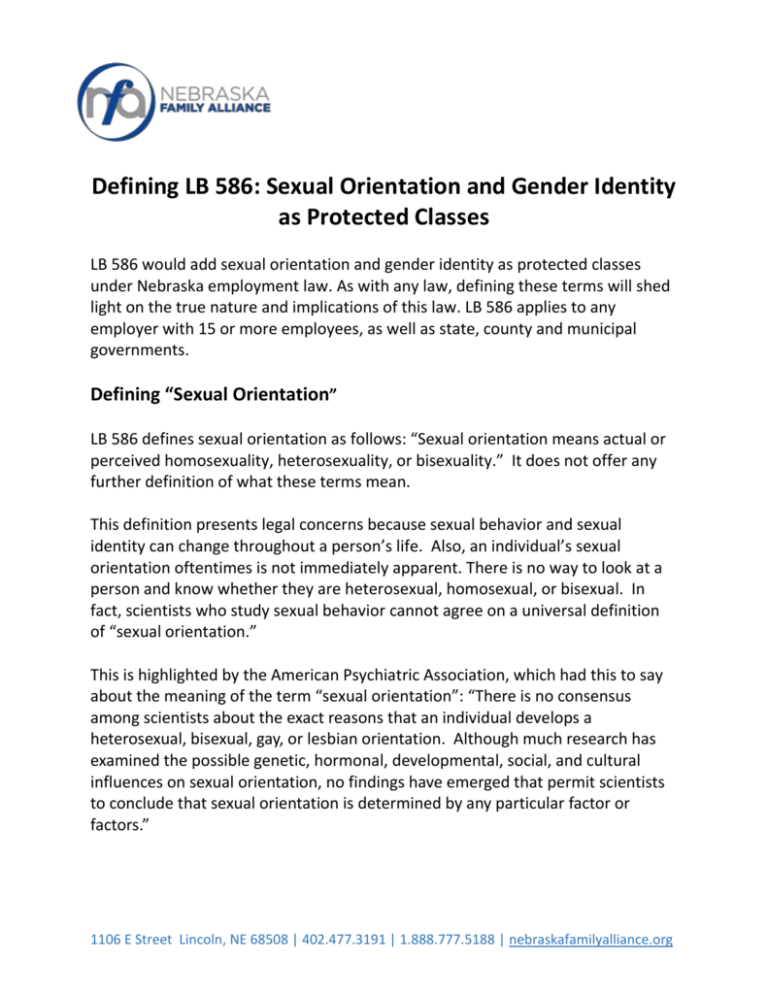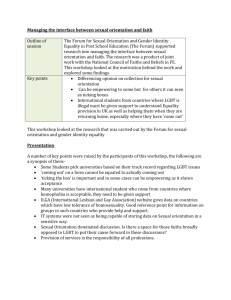
Defining LB 586: Sexual Orientation and Gender Identity
as Protected Classes
LB 586 would add sexual orientation and gender identity as protected classes
under Nebraska employment law. As with any law, defining these terms will shed
light on the true nature and implications of this law. LB 586 applies to any
employer with 15 or more employees, as well as state, county and municipal
governments.
Defining “Sexual Orientation”
LB 586 defines sexual orientation as follows: “Sexual orientation means actual or
perceived homosexuality, heterosexuality, or bisexuality.” It does not offer any
further definition of what these terms mean.
This definition presents legal concerns because sexual behavior and sexual
identity can change throughout a person’s life. Also, an individual’s sexual
orientation oftentimes is not immediately apparent. There is no way to look at a
person and know whether they are heterosexual, homosexual, or bisexual. In
fact, scientists who study sexual behavior cannot agree on a universal definition
of “sexual orientation.”
This is highlighted by the American Psychiatric Association, which had this to say
about the meaning of the term “sexual orientation”: “There is no consensus
among scientists about the exact reasons that an individual develops a
heterosexual, bisexual, gay, or lesbian orientation. Although much research has
examined the possible genetic, hormonal, developmental, social, and cultural
influences on sexual orientation, no findings have emerged that permit scientists
to conclude that sexual orientation is determined by any particular factor or
factors.”
1106 E Street Lincoln, NE 68508 | 402.477.3191 | 1.888.777.5188 | nebraskafamilyalliance.org
Defining “Gender Identity”
LB 586 defines gender identity as follows: “Gender identity shall mean the actual
or perceived appearance, expression, identity, or behavior of an individual,
whether or not that appearance, expression, identity, or behavior is different
from the individual’s assigned sex at birth.”
This definition presents legal concerns as well, but it also has important cultural
concerns. Defining gender according to the way people express their gender
fundamentally disconnects gender and biology. The full implications of this subtle
shift are not immediately apparent. So, what does it mean?
Adding gender identity as a legally protected class would mean that a person
would have the right to choose their gender irrespective of their biological sex.
Legally speaking an employer would be prohibited from considering the way that
an employee or potential employee chooses to “express” their gender. For
example, an employer could not prohibit a man from wearing women’s clothing in
the workplace or a woman from using the men’s restroom.
Before going any further, one thing must be clear: the challenges faced by
transgender individuals and those with Gender Identity Disorder are real. Gender
Identity Disorder is defined by strong, persistent feelings of identification with the
opposite gender and discomfort with one’s own biological sex. Social isolation,
depression, suicide, self-hatred, intense anxiety concerning appearance, as well as
being constantly plagued by the sense that you are living in the wrong body, are
just a few of the challenges these individuals face.i
The scientific community does not agree on the prevalence of Gender Identity
Disorder. Numbers can range from 1:30,000 to 1:250. Regardless of the ratio, it
does not change the fact that men are men and women are women. No matter
how much compassion we have for people or how much we care about them,
creating a protected class for how masculine or feminine people want to be
perceived just does not make sense.
1106 E Street Lincoln, NE 68508 | 402.477.3191 | 1.888.777.5188 | nebraskafamilyalliance.org
The Problem of “Perceived”
After reviewing the legal and cultural problems with the way that sexual
orientation and gender identity are defined we must review a third word that
presents difficulties. LB586 prohibits discrimination on the basis of an individual’s
“perceived” sexual orientation and gender identity.
First we ought to ask: what is meant by the word “perceived”? Perceived by
whom? It could be the employer doing the perceiving. But the use of the
possessive case suggests it is the individual’s perceived sexual orientation or
gender identity. Either way, there is dangerous ambiguity in LB 485’s use of
language that sets up a legal framework that singles out — either for punishment
or special protection — personal perceptions.
When a plaintiff swears that an employer’s perceptions are malicious, how does
the employer defend himself? Is accusing an employer of “perceptions” enough
to insist on punitive damages? On the other hand, if the law purports to protect
our self-perceptions, then we’re still on a shaky foundation. Self-perceptions can
change over time and can be based on many different factors. There are countless
self-perceptions a person can have, each one of them complex. Feelings change.
One’s sense of identity can change. Any law that’s set up to protect or punish
perceptions is suspect and conducive to abuse. LB586 offers boundless
possibilities for thought policing in the workplace and society at large. And it
opens the door to endless litigation against employers.
Citations
i
Gender Identity Disorder, Psychology Today, (https://www.psychologytoday.com/conditions/genderidentity-disorder (last visited Feb. 16, 2015).
1106 E Street Lincoln, NE 68508 | 402.477.3191 | 1.888.777.5188 | nebraskafamilyalliance.org







